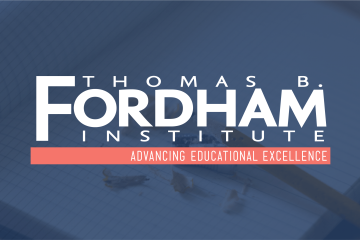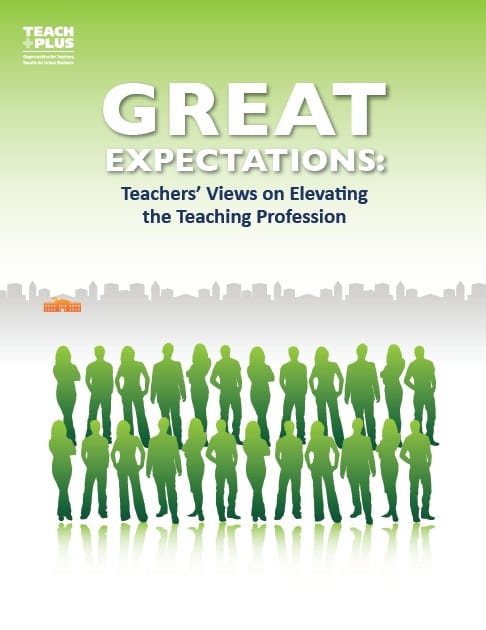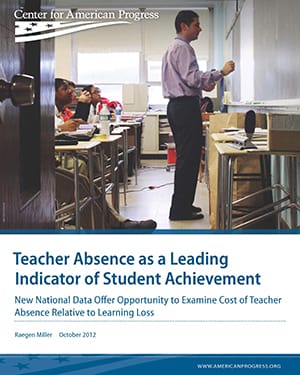
The Best Teachers in the World: Why We Don't Have Them and How We Could
Student nomads: Mobility in Ohio’s schools
The Best Teachers in the World: Why We Don't Have Them and How We Could

Teacher Absence as a Leading Indicator of Student Achievement

The Achievable Dream: College Board Lessons on Creating Great Schools

Great Expectations: Teachers’ Views on Elevating the Teacher Profession

The votes are in

Untouchable?

Student nomads: Mobility in Ohio’s schools

Education recovers from elections and super storms

A not-so-great night for education reform

Untouchable?

Untouchable?

The Best Teachers in the World: Why We Don't Have Them and How We Could

Teacher Absence as a Leading Indicator of Student Achievement

The Achievable Dream: College Board Lessons on Creating Great Schools

Great Expectations: Teachers’ Views on Elevating the Teacher Profession

The Best Teachers in the World: Why We Don't Have Them and How We Could
 In 135 pages (not including a swell foreword by Benno Schmidt), John Chubb does a fine job of examining key barriers to teacher quality in American public education and suggesting three big strategies for overcoming them. He unpacks 1) the potential of technology to augment the teacher arsenal (by reducing the total number of flesh-and-blood teachers that the system needs and thus advancing selectivity and compensation); 2) teacher preparation and the enforcement of quality and effectiveness in that domain, primarily via information and market forces; and 3) how to empower principals to staff their schools with individuals best suited to meeting the instructional needs and priorities of those schools. This paragraph gives you the flavor:
In 135 pages (not including a swell foreword by Benno Schmidt), John Chubb does a fine job of examining key barriers to teacher quality in American public education and suggesting three big strategies for overcoming them. He unpacks 1) the potential of technology to augment the teacher arsenal (by reducing the total number of flesh-and-blood teachers that the system needs and thus advancing selectivity and compensation); 2) teacher preparation and the enforcement of quality and effectiveness in that domain, primarily via information and market forces; and 3) how to empower principals to staff their schools with individuals best suited to meeting the instructional needs and priorities of those schools. This paragraph gives you the flavor:
In exchange for the freedom, schools, and, especially, school leaders must be held strictly to account for student programs. That is the bargain that professionals should want—autonomy to control their work fully, to be compensated for it fairly, and to accept responsibility for its results. This is a very different arrangement than the one that has long governed education—and that now impedes the improvement of teacher quality. Policymakers need to take a fundamentally different approach. Teacher quality cannot be prescribed.
Chubb is exceptionally qualified to author this book. Currently acting chief of Education Sector, a policy think tank, he formerly spent seventeen years with EdisonLearning, where he served as chief education officer. Then there’s his distinguished career in political science, education policy, and international-education consulting. Reformers should take this book seriously, particularly because it comes at teacher quality from a very different direction than the “top down” schemes that most are now pursuing—with the best of intentions, of course, but with little to show for their efforts.
SOURCE: John E. Chubb, The Best Teachers in the World: Why We Don't Have Them and How We Could (Stanford, CA: Education Next Books, Hoover Institution Press, 2012).

Teacher Absence as a Leading Indicator of Student Achievement
The sun rises in the East. Grass is green. And teachers are the most important in-school factor in determining student achievement. This last truth has long guided the push for more robust teacher-preparation programs, heartier evaluation systems, and altered HR policies. This short report by Raegen Miller highlights another strategy, small but fruitful, for eking more out of today’s instructional workforce: Ensure that teachers come to school each day. Using data from the Civil Rights Data Collection survey, Miller discovers that, on average, 36 percent of teachers were absent (whether for sick or disability leave or vacation time) ten or more days during the 2009-10 school year. Nationally, these missed school days cost taxpayers $4 billion. Interestingly, about two-thirds of the variance in chronic-absenteeism rates exists between districts within states—highlighting the power that district policies and bargaining agreements play in determining these rates. (In that vein: Charter-school teachers were 15 percentage points less likely to be truant than their peers in district schools.) Miller further dissects the data by school level and student race (predominantly black schools face higher rates of teacher absenteeism), but he stops short of analyzing them by socioeconomic status—a key shortcoming of the report. (The coarse data necessarily used here leave further questions unanswered regarding total amount of leave taken and type of leave requested.) While not a comprehensive assessment, Miller’s report does bring this key inadequacy in K-12 education to the fore—and reveals some startlingly stark information.
SOURCE: Raegen Miller, Teacher Absence as a Leading Indicator of Student Achievement (Washington, D.C.: Center for American Progress, November 2012).

The Achievable Dream: College Board Lessons on Creating Great Schools
Thirteen profiles (of quality school leaders, innovative big thinkers, and stellar teachers) comprise this volume by former College Board president Gaston Caperton (with Richard Whitmire)—and provide quite a “who’s who” in education: Mike Miles and the Harrison County School District’s pay for performance system is featured, along with David Steiner and the Relay Graduate School of Education and Chris Steinhauser and the Long Beach School District. Into each narrative, Caperton laces lessons that he’s garnered over his long career in the private, public, and nonprofit sectors on how to achieve great, equitable schools for all. None of it is mystical, which doesn’t mean it’s not worth heeding: Improve teacher quality by recruiting top-flight candidates. Increase rigor with high expectations, consistent use of data, and comprehensive AP programs. And embrace accountability. He also lauds inner-city exam schools. While not breaking new ground, Caperton utilizes his knowledge (and Whitmire’s fine storytelling capacity) to provide an encouraging set of strategies and examples that point toward a more equitable and effective education system.
SOURCE: Gaston Caperton and Richard Whitmire, The Achievable Dream: College Board Lessons on Creating Great Schools (New York, NY: College Board, 2012).

Great Expectations: Teachers’ Views on Elevating the Teacher Profession
 Baby-boomer retirements and mid-career (or early career!) departures have helped render America’s teaching force the greenest it has ever been. Does that mean it’s more receptive than ever to reforms? So you will read in this survey report from Teach Plus (interesting, even if the survey methods aren’t terribly rigorous). Of the “new majority” (teachers with ten or fewer years of experience), 71 percent favored using student gains as a factor in teacher evaluations. (Only 41 percent of veterans felt the same way.) Newbies were also more likely than veterans (42 versus 15 percent) to favor a new compensation system with higher tenure standards and higher starting and top salaries. Still, these young teachers are not ardent reformers: Neither subset of educators was willing to take larger class sizes for higher salaries, for example. Nor did either think that longer school days are necessary to increase achievement. How to leverage these findings to change teacher policy? The report offers one smart recommendation (building off the mission of Teach Plus itself): Encourage “new majority” teachers to seek leadership roles in their unions and districts.
Baby-boomer retirements and mid-career (or early career!) departures have helped render America’s teaching force the greenest it has ever been. Does that mean it’s more receptive than ever to reforms? So you will read in this survey report from Teach Plus (interesting, even if the survey methods aren’t terribly rigorous). Of the “new majority” (teachers with ten or fewer years of experience), 71 percent favored using student gains as a factor in teacher evaluations. (Only 41 percent of veterans felt the same way.) Newbies were also more likely than veterans (42 versus 15 percent) to favor a new compensation system with higher tenure standards and higher starting and top salaries. Still, these young teachers are not ardent reformers: Neither subset of educators was willing to take larger class sizes for higher salaries, for example. Nor did either think that longer school days are necessary to increase achievement. How to leverage these findings to change teacher policy? The report offers one smart recommendation (building off the mission of Teach Plus itself): Encourage “new majority” teachers to seek leadership roles in their unions and districts.
SOURCE: Mark Teoh and Celine Coggins, Great Expectations: Teachers’ Views on Elevating the Teacher Profession (Boston, MA: Teach Plus, October 2012).

The votes are in
Is education-funding “blackmail” fair play? Did teacher unions come out on top? Mike and Dara rehash Tuesday’s electoral results while Amber asks whether increased voucher accountability makes a difference.
Amber's Research Minute
School Choice and School Accountability: Evidence from a Private Voucher Program in Milwaukee, Wisconsin - Download PDF

Untouchable?
Mike Petrilli and Ty Eberhardt discuss the soft spots in President Obama's education record.
For a more in depth view at the president's education record, please read the article on Education Next.

Student nomads: Mobility in Ohio’s schools
Many schools throughout the land have revolving enrollment doors: large numbers of pupils who enter and leave during the same school year. In such circumstances, teachers face nonstop interruptions and the challenge of integrating new students (at various levels of achievement, with various family circumstance, etc.) into their classrooms and curricula, even as they struggle to maintain the pace of learning for those who have been in class all year. Districts are tasked with making mid-year transportation arrangements for new arrivers, as well as accommodating unanticipated demands for special-education services, English-language instruction, and more. It’s a huge challenge. But it’s also sometimes proffered as an excuse, as in, “How can you hold us responsible for the education of kids who have only been in our classrooms for part of the year?” And it surely complicates results-based accountability schemes and value-added measures.
 Ohio schools struggle with revolving enrollment doors. Photo by Jason Trevino. |
Yet despite the burden of pupil mobility, the research on it is slim and data are scant; no one has systematically examined its scale or patterns across an entire state.
Recognizing that void, we at the Thomas B. Fordham Institute set out to document and try to understand both the extent of mobility and its crucial particulars, such as whether all the movement is from district to charter schools and whether kids migrate from bad schools to better ones. A 2010 analysis in Dayton further whet our appetite: The findings from that county-wide research were astonishing, showing enormous movement of students within the district, across and between district and charter schools (in both directions!), and across district lines.
What about the rest of the state? Working with Community Research Partners (CRP) and ten funding partners, with encouragement and much data assistance from the Ohio Department of Education, we launched an ambitious analysis of student mobility throughout Ohio. Using over 6 million student records, we’ve been able to gauge the movement of pupils across and among the state’s 3,500-plus public (district and charter) school buildings as well as e-schools. CRP also dove deeply into five metro areas—Cincinnati, Cleveland, Columbus, Dayton, and Toledo. The results of this ambitious project (being released today) are wide-ranging and fundamental, as Ohio educators and policymakers seek better understanding of how education systems function (or don’t) with an ever-shifting pupil population. Nor is there any reason to suppose that the realities—and challenges—are much different in other states.
What did we find?
Mobility is enormous.
Ohio has 1.7 million public school students attending over 3,500 schools and affords these students many policy-driven opportunities to move among schools. Families may opt for charter schools (of which there are about 350), full-time e-schools (there are seven statewide e-schools and about twenty regional or local ones), or open-enrollment schools (78 percent of the state’s 610 school districts accept students who live outside their borders). Students also have intra-district options such as magnet and alternative schools, or they may simply request a spot in a district school other than the one to which they are assigned. (Ohio also has four publicly funded voucher programs, not included in this study due to lack of data.)
A great deal of student mobility, however, has nothing to do with intentional policy. To gauge its magnitude, CRP looked at stability rates (the percentage of a school’s students who stay there for at least two years) and churn rates (the number of student admits and withdrawals over one year) in every Ohio public school.
Both metrics were disconcertingly high for charter and district schools alike.
The median building churn rate was 10.6 percent for all Ohio districts and thrice that (31.5 percent) in fifteen urban districts. Charter schools’ churn rate was comparable to urban districts at 27.2 percent.[1]Those averages, however, conceal huge variation. In the Cincinnati area, only three of the thirty-seven largest charter schools had stability rates above 70 percent; in the Dayton Public Schools, only 69 percent of a cohort of K-7 students remained in the same building over two years. Southmoor Middle School, a low-income Columbus City School, kept only one in two students over the two-year period. To put its churn rate of 52 percent in perspective, an average classroom with twenty-five students would have had to cope with thirteen student arrivals or departures during the 2010-11 school year. High levels of mobility also afflict many suburban and rural schools: For example, Griffith Thomas, a high-wealth suburban school, lost nearly one quarter of its students over two years.
Persistently mobile students don’t do as well in school as their more stable peers.
It turns out—unsurprisingly—that frequent school movers face a general downward trend in test scores and passage rates. Those who moved multiple times during our two-year study don’t do as well as their peers, and there is a relationship between mobility rates, student demographics, and test scores. Take, for example, the average scores on the spring 2011 third-grade state math test in the Columbus City Schools: Scores were lowest for poor youngsters, African American youngsters, and those students who moved multiple times. Predictably, a disproportionate number of multiple movers were also poor and minority. Combine those three characteristics and you have the makings of a lifetime of school failure starting by the end of third grade.
Student mobility isn’t always bad.
This study indicates that there is a fair amount of upward student mobility in the Buckeye State. Consider, for example, the number of students moving from failing urban public schools (D- or F-rated) to more successful suburban schools (A- or B-rated schools) in metro Columbus: Of the 5,473 students over two years who exited Columbus City Schools (CCS) for another district, 52 percent moved to schools with performance ratings at least two ranks higher than their CCS schools of origin. The percentages were similar for Cincinnati, Cleveland, Dayton, and Toledo, suggesting that many kids in Ohio’s major urban (and comparatively low-performing) districts are moving to a better situation when they change schools. Of course, this also means that nearly half of movers enter lower performing schools, which should cause some soul-searching among school-choice advocates about the quality of the schooling options among which students are choosing.
Now what?
Mobility is a fact of life for schools in many parts of the state, whether rural, suburban, and urban schools. The present research—and trove of data that it contains—doesn’t tell us what to do about it, how to accent its benefits and minimize its detriments. Others need to dig deeper and weigh in on the implications for policy and practice. But the data at hand already signal to those of us who care about education, in Ohio and around the country, that we should take seriously the very real challenges these findings pose for all policies involving school choice, funding, and accountability.
A version of this editorial appeared on the Ohio Gadfly Daily blog.

Education recovers from elections and super storms
 Hurricane Sandy temporarily shuttered 198 school districts in New York City and more than 300 in New Jersey last week, amounting to what Education Week called one of the “largest disruptions to schooling in the United States in recent years.” When most Big Apple students returned to school on Monday, they faced gridlock that would make even the most jaded New Yorker balk: packed trains, long lines at bus stops, and persistent gas shortages. Our hats our off to the Gotham teachers, parents, and students who overcame these obstacles and more to keep kids learning this week.
Hurricane Sandy temporarily shuttered 198 school districts in New York City and more than 300 in New Jersey last week, amounting to what Education Week called one of the “largest disruptions to schooling in the United States in recent years.” When most Big Apple students returned to school on Monday, they faced gridlock that would make even the most jaded New Yorker balk: packed trains, long lines at bus stops, and persistent gas shortages. Our hats our off to the Gotham teachers, parents, and students who overcame these obstacles and more to keep kids learning this week.
For aspiring education know-it-alls, Goldman Sachs has a simple (and lucrative) challenge: Explain what we should do to create a strong U.S. education system that works for all, improves student outcomes, and enables our country to regain its leadership position in the field of education—in three pages or less. The best entry will garner one lucky person a cool $10,000 (and the ancillary benefit of having mapped out a way to fix education). Gadfly would enter, but just can’t seem to explain Reform Realism in less than four pages.
President Obama will have quite the agenda in his upcoming term—what should he and Arne Duncan tackle first? Will they jump right to Head Start reform? Perhaps crack down on states and districts not living up to promises they made to acquire Race to the Top funding? Here’s one prediction: It won’t be ESEA reauthorization. Crazy as it may seem, a still-divided congress and the breathing room NCLB waivers provided mean it really could be several more years before we see the feds renew the nation’s most important education law.
School-choice advocates would do well to remember that even with this week’s victory in Georgia and probable victory in Washington State, there are plenty of people in need of convincing. Now is not the time to rest on laurels. More voters in the Evergreen State thought it was a good idea to legalize pot on Tuesday than to legalize charter schools.

A not-so-great night for education reform
The results are in and Ed Reform, our non-partisan candidate, had a mixed performance. Let’s see how eight key races and referenda turned out:
- Tony Bennett lost his re-election bid. There’s no sugar-coating it: This one hurts. Bad. As I wrote on Tuesday (and profanely explained to the Huffington Post), this was a referendum on the most aggressive reform agenda in the country. Despite being massively outspent, the unions managed to get one of their own elected to this critical post. We’ll have to wait for more data to determine the degree to which conservatives also punished Bennett for his support of the Common Core (perhaps inadvertently egged on by Arne Duncan’s tone-deaf cheerleading). But it’s no secret that some of them are gleeful. If they were the deciding factor, it will go down as one of the stupidest moves in the annals of education-policy history. Bennett will be fine (I suspect he’s already getting calls from Florida, Ohio, and other states looking for a hard-charging education leader). But a union-backed state superintendent is going to do her best to wreak havoc on the state’s new voucher program and much else. (Just ask choice supporters in Wisconsin, where state superintendent Tony Evers has made life hard on choice schools for years.) Bad, bad, sad.
- And then there were nine. They were still counting the votes in Washington through this morning—and it looks to be a squeaker—but the most populous of the ten states that lacked charter-school laws before Tuesday will finally get a taste of school choice. A victory is a victory, and charter schools are on their way to Washington.
- Idaho’s “Luna Laws” went down. This is bad but not surprising, reminiscent of the repeal of Ohio’s Senate Bill 5 reforms in 2011. Once again, the unions were well organized and determined to overturn measures (supported by GOP state supe Tom Luna) related to collective bargaining, teacher evaluations, and technology. A similar reform package was defeated in South Dakota, too. Remember when we told you (last week) that it’s not just the teacher unions on the coasts and in the industrial Midwest that are powerful? We weren’t kidding.
- Reformers won on collective bargaining in Michigan. On the other hand, Michigan’s powerful teacher union lost its bid to enshrine expansive collective-bargaining rights in the state constitution. The status quo—which is still pretty darn union-friendly—remains in place.
- Georgia voters approved a statewide charter-school authorizer. Put another win in the reform column; this should allow charter schooling in the Peach State to flourish, as schools won’t have to rely on approval from their competition (local school districts).
- Wisconsin Republicans regained the state senate. This means that Scott Walker’s collective-bargaining reforms and the recent expansion of the state’s voucher program are safe for now. (Unless the courts intervene, that is.)
- Republicans kept their supermajority in Indiana’s General Assembly—and a reformist GOP governor will take Mitch Daniels’s chair. This seems to indicate that while Tony Bennett paid for his far-sighted reform agenda, Republicans who enacted it did not. It also provides further evidence that Bennett may have been punished for his support of the Common Core.
- The Cleveland Plan moves towards reality. A program as ambitious as the one developed on the shores of Lake Erie over the past year is bound to have its share of drama, from hard-fought statehouse battles to outside critics parachuting in to throttle it. Tuesday’s vote to fund Mayor Frank Jackson’s vision, a Cleveland education system that focuses on school quality over politics and refuses to discriminate against charters (or give a free pass to bad ones), was relatively mundane in comparison. But it was the first school levy to win the support of Cleveland voters since 1996—and it was a big one. Here’s hoping the next dramatic act will be the progress that city schools see once the plan is implemented.
 Ed Reform Idol Tony Bennett's loss was an unexpected blow. Photo by Joe Portnoy. |
So yes, for those of you keeping score, that’s six wins for Ed Reform and two losses (although plenty of other issues decided on Tuesday hold important implications for local schooling). In my book, however, the Bennett defeat looms so large as to crush any celebration.
What does this mixed pattern mean for school reform? It’s hard to say. Did Bennett and Luna push too far, too fast with their suite of reforms? Maybe. Or did they simply not raise enough money to fend off challenges? (Is it finally time for Republicans for Education Reform—a DFER equivalent that could come to the aid of bold conservative reformers?)
One thing is for sure: Indiana is going to be a fascinating place to watch, as a Republican governor and strongly Republican legislature do battle with a union-backed Democratic state superintendent.
No victories are permanent. But neither are defeats. The fight goes on.

Untouchable?
Mike Petrilli and Ty Eberhardt discuss the soft spots in President Obama's education record.
For a more in depth view at the president's education record, please read the article on Education Next.

Untouchable?
Mike Petrilli and Ty Eberhardt discuss the soft spots in President Obama's education record.
For a more in depth view at the president's education record, please read the article on Education Next.

The Best Teachers in the World: Why We Don't Have Them and How We Could
 In 135 pages (not including a swell foreword by Benno Schmidt), John Chubb does a fine job of examining key barriers to teacher quality in American public education and suggesting three big strategies for overcoming them. He unpacks 1) the potential of technology to augment the teacher arsenal (by reducing the total number of flesh-and-blood teachers that the system needs and thus advancing selectivity and compensation); 2) teacher preparation and the enforcement of quality and effectiveness in that domain, primarily via information and market forces; and 3) how to empower principals to staff their schools with individuals best suited to meeting the instructional needs and priorities of those schools. This paragraph gives you the flavor:
In 135 pages (not including a swell foreword by Benno Schmidt), John Chubb does a fine job of examining key barriers to teacher quality in American public education and suggesting three big strategies for overcoming them. He unpacks 1) the potential of technology to augment the teacher arsenal (by reducing the total number of flesh-and-blood teachers that the system needs and thus advancing selectivity and compensation); 2) teacher preparation and the enforcement of quality and effectiveness in that domain, primarily via information and market forces; and 3) how to empower principals to staff their schools with individuals best suited to meeting the instructional needs and priorities of those schools. This paragraph gives you the flavor:
In exchange for the freedom, schools, and, especially, school leaders must be held strictly to account for student programs. That is the bargain that professionals should want—autonomy to control their work fully, to be compensated for it fairly, and to accept responsibility for its results. This is a very different arrangement than the one that has long governed education—and that now impedes the improvement of teacher quality. Policymakers need to take a fundamentally different approach. Teacher quality cannot be prescribed.
Chubb is exceptionally qualified to author this book. Currently acting chief of Education Sector, a policy think tank, he formerly spent seventeen years with EdisonLearning, where he served as chief education officer. Then there’s his distinguished career in political science, education policy, and international-education consulting. Reformers should take this book seriously, particularly because it comes at teacher quality from a very different direction than the “top down” schemes that most are now pursuing—with the best of intentions, of course, but with little to show for their efforts.
SOURCE: John E. Chubb, The Best Teachers in the World: Why We Don't Have Them and How We Could (Stanford, CA: Education Next Books, Hoover Institution Press, 2012).

Teacher Absence as a Leading Indicator of Student Achievement
The sun rises in the East. Grass is green. And teachers are the most important in-school factor in determining student achievement. This last truth has long guided the push for more robust teacher-preparation programs, heartier evaluation systems, and altered HR policies. This short report by Raegen Miller highlights another strategy, small but fruitful, for eking more out of today’s instructional workforce: Ensure that teachers come to school each day. Using data from the Civil Rights Data Collection survey, Miller discovers that, on average, 36 percent of teachers were absent (whether for sick or disability leave or vacation time) ten or more days during the 2009-10 school year. Nationally, these missed school days cost taxpayers $4 billion. Interestingly, about two-thirds of the variance in chronic-absenteeism rates exists between districts within states—highlighting the power that district policies and bargaining agreements play in determining these rates. (In that vein: Charter-school teachers were 15 percentage points less likely to be truant than their peers in district schools.) Miller further dissects the data by school level and student race (predominantly black schools face higher rates of teacher absenteeism), but he stops short of analyzing them by socioeconomic status—a key shortcoming of the report. (The coarse data necessarily used here leave further questions unanswered regarding total amount of leave taken and type of leave requested.) While not a comprehensive assessment, Miller’s report does bring this key inadequacy in K-12 education to the fore—and reveals some startlingly stark information.
SOURCE: Raegen Miller, Teacher Absence as a Leading Indicator of Student Achievement (Washington, D.C.: Center for American Progress, November 2012).

The Achievable Dream: College Board Lessons on Creating Great Schools
Thirteen profiles (of quality school leaders, innovative big thinkers, and stellar teachers) comprise this volume by former College Board president Gaston Caperton (with Richard Whitmire)—and provide quite a “who’s who” in education: Mike Miles and the Harrison County School District’s pay for performance system is featured, along with David Steiner and the Relay Graduate School of Education and Chris Steinhauser and the Long Beach School District. Into each narrative, Caperton laces lessons that he’s garnered over his long career in the private, public, and nonprofit sectors on how to achieve great, equitable schools for all. None of it is mystical, which doesn’t mean it’s not worth heeding: Improve teacher quality by recruiting top-flight candidates. Increase rigor with high expectations, consistent use of data, and comprehensive AP programs. And embrace accountability. He also lauds inner-city exam schools. While not breaking new ground, Caperton utilizes his knowledge (and Whitmire’s fine storytelling capacity) to provide an encouraging set of strategies and examples that point toward a more equitable and effective education system.
SOURCE: Gaston Caperton and Richard Whitmire, The Achievable Dream: College Board Lessons on Creating Great Schools (New York, NY: College Board, 2012).

Great Expectations: Teachers’ Views on Elevating the Teacher Profession
 Baby-boomer retirements and mid-career (or early career!) departures have helped render America’s teaching force the greenest it has ever been. Does that mean it’s more receptive than ever to reforms? So you will read in this survey report from Teach Plus (interesting, even if the survey methods aren’t terribly rigorous). Of the “new majority” (teachers with ten or fewer years of experience), 71 percent favored using student gains as a factor in teacher evaluations. (Only 41 percent of veterans felt the same way.) Newbies were also more likely than veterans (42 versus 15 percent) to favor a new compensation system with higher tenure standards and higher starting and top salaries. Still, these young teachers are not ardent reformers: Neither subset of educators was willing to take larger class sizes for higher salaries, for example. Nor did either think that longer school days are necessary to increase achievement. How to leverage these findings to change teacher policy? The report offers one smart recommendation (building off the mission of Teach Plus itself): Encourage “new majority” teachers to seek leadership roles in their unions and districts.
Baby-boomer retirements and mid-career (or early career!) departures have helped render America’s teaching force the greenest it has ever been. Does that mean it’s more receptive than ever to reforms? So you will read in this survey report from Teach Plus (interesting, even if the survey methods aren’t terribly rigorous). Of the “new majority” (teachers with ten or fewer years of experience), 71 percent favored using student gains as a factor in teacher evaluations. (Only 41 percent of veterans felt the same way.) Newbies were also more likely than veterans (42 versus 15 percent) to favor a new compensation system with higher tenure standards and higher starting and top salaries. Still, these young teachers are not ardent reformers: Neither subset of educators was willing to take larger class sizes for higher salaries, for example. Nor did either think that longer school days are necessary to increase achievement. How to leverage these findings to change teacher policy? The report offers one smart recommendation (building off the mission of Teach Plus itself): Encourage “new majority” teachers to seek leadership roles in their unions and districts.
SOURCE: Mark Teoh and Celine Coggins, Great Expectations: Teachers’ Views on Elevating the Teacher Profession (Boston, MA: Teach Plus, October 2012).

